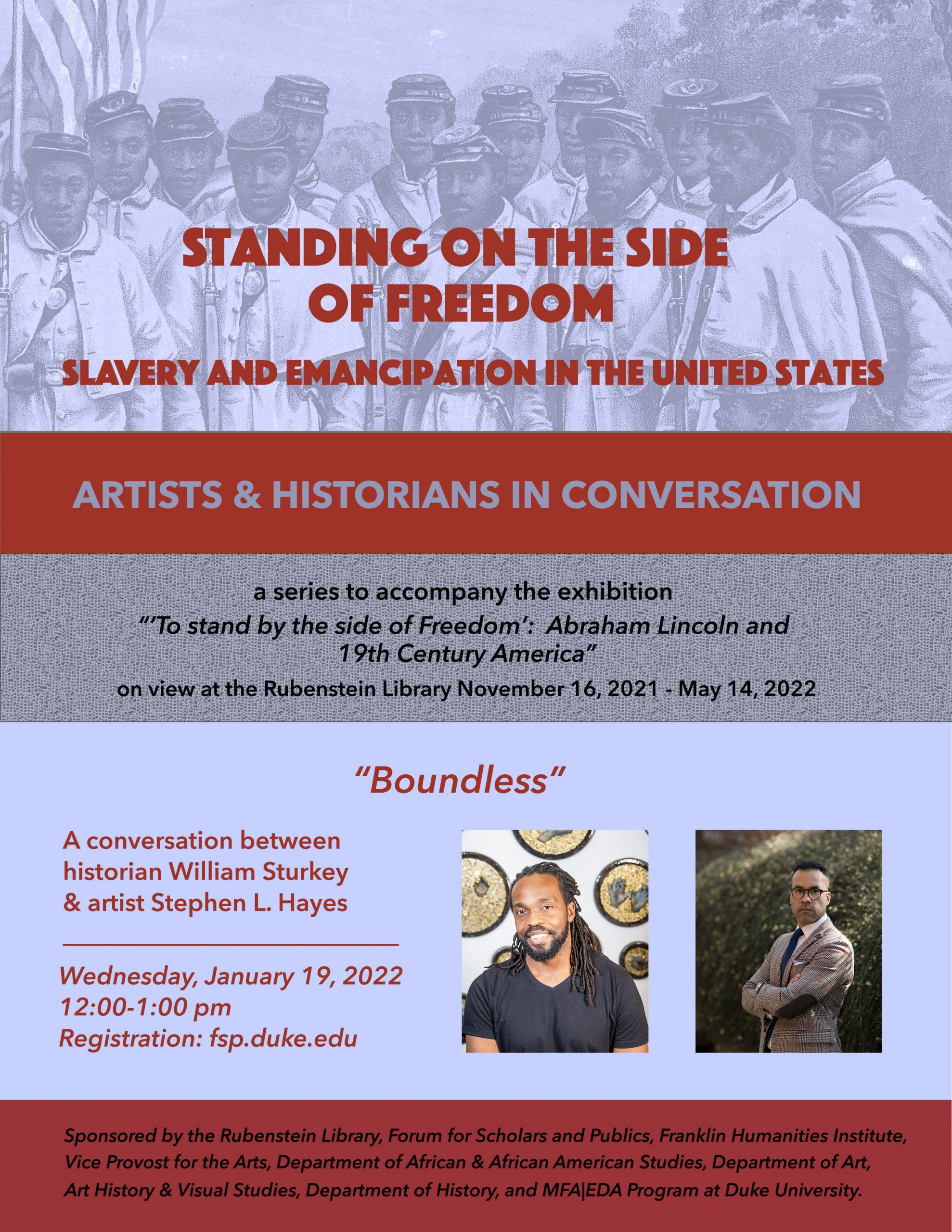Search
[wd_asp id=1]“Boundless”

"Boundless"
A conversation between historian William Sturkey and artist Stephen L. Hayes
Join us on Wednesday, January 19, at noon for an exploration of the role of art in creating knowledge and narratives about slavery, the Civil War, and freedom struggles in the United States. Historian William Sturkey will guide this conversation with professor and artist Stephen L. Hayes.
Commissioned by the Cameron Museum of Art in Wilmington, North Carolina, Hayes' sculpture, "Boundless," honors the U.S. Colored Troops - Black soldiers who served in the Union Army in the Civil War. In an interview with the Wilmington StarNews, Hayes said, “As a Black man in America, you see the imagery of a Black person in chains, being whipped, begging, kneeling and helpless. This project is important to me because, as a creator, I get to change that narrative — by giving Black soldiers a sense of honor and pride.”
This event is part of a series accompanying the exhibition, "'To stand by the side of Freedom': Abraham Lincoln and 19th century America," on view at the Rubenstein Library through May 14, 2022.
Free and open to the public. Advance registration required. We have updated this description to reflect that the event is now virtual only. We regret that we cannot yet gather in person.
Sponsored by the Rubenstein Library, Forum for Scholars and Publics, Franklin Humanities Institute, Vice Provost for the Arts, Department of African & African American Studies, Department of Art, Art History & Visual Studies, Department of History, and MFA|EDA Program at Duke University.
Update October 2022
You can now watch the full video of this discussion on our YouTube channel
Read an excerpt of the discussion on the scale and location of Hayes' sculpture, "Boundless" at the Cameron Art Museum in Wilmington, NC:
William Sturkey: So I went down and saw the sculpture, and...there was a field trip there. I think the kids must've been like eight, nine, 10 years old. And they were all running all over the place, but it seemed like they were really enjoying it. One of the things that really struck me was the actual place. So much of art obviously is located in museums or libraries, things like that, or even the center of town squares, which we'll talk about in a minute. So what did it mean to you to locate this monument literally on the exact same grounds where those men once passed through?
Stephen Hayes: I think it meant a lot, because being able to create this monument and have it on the grounds, to say, "They actually walked on this earth," made a whole lot of sense to me. And also being able to cast the bust of these descendants, and thinking about the generations to come further along. Those kids who came along, imagine this 15, 20 years from now, and their grandchild comes along saying, "Hey, that was my great-granddaddy who marched right here, that's his face...My great-great granddaddy was one of the soldiers who marched for our freedoms here." So that meant so much to me. Instead of it being on a pedestal, they're on the ground...the people (can) be a part of it. So that's one of the main reasons why I felt like this was a very important statue to create. It's not looking down and towering over everyone, it's eye to eye."
Speakers
Stephen L. Hayes
Duke University
Stephen L. Hayes grew up in Durham with his older brother, Spence, and his mother, Lender, who were pivotal in shaping and sparking his creative approach. When Hayes was in first grade, he broke a remote-control car. His brother took it apart and attached the motor to a battery, bringing…...
Read MoreWilliam Sturkey
University of North Carolina at Chapel Hill
Dr. William Sturkey is an historian of the post-1865 United States at the University of North Carolina, Chapel Hill. Specializing in the history of race in the American South, most of his research centers the experiences of working-class racial minorities. His first book, To Write in the Light of Freedom,…...
Read More
check us out
on social media